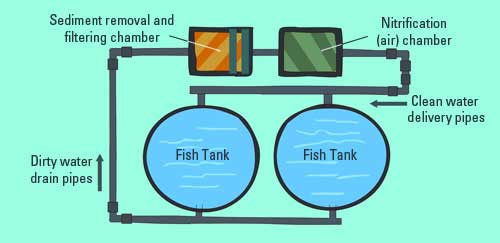 |
Types of Aquaculture
Below are a few common types of aquaculture systems
Inland Pond Culture
This usually involves inland artificial ponds of about 20 acres in size and about 6-8ft deep. It is common to see aeration systems connected to the pond, to introduce air into the ponds. This enhances the supply of oxygen and also reduces ice formation in the winter season.
In China, over 75% of the farmed freshwater fish are produced in constructed ponds and in the U.S. nearly all of the farmed catfish are raised in ponds.
Recirculating systems
This involves a closed set of chambers (units) where fish is kept in one and water treatment kept in another. It is highly dependent on power supply, as water has to be pumped constantly through the fish chambers. As water flows through the treatment chamber, particulate matter is filtered out and air introduced. This closed system helps to control the salinity, temperature, oxygen and anything that can cause harm to the fish.

It is considered an environmentally friendlier system because very little new water is introduced to replace water that evaporated. The residue from the filters is also disposed off in a responsible manner.
Open-net pen and Cage systems
This system is often found offshore and in fresh water lakes. Mesh cages of between 6 and 60 cubic feet (pens) are installed in the water with the fish inside it. With high concentration of fish in the pens, waste, chemicals, parasites and diseases are often exchanged in the immediate water environments. The fish also attract predatory animals (bigger fish), which are often entangled in the nets. This system uses public water, therefore environmental regulation and some authorization protocols must be respected.
Flow-through / raceway
This is a system made of long units stocked with fish. The units have feeding stations attached to them. Water is diverted from flowing water and fed into the raceway units flowing down stream. Down the end of the unit, waste is collected and disposed of. Raceways are common for culturing trout.
 
|
 |

